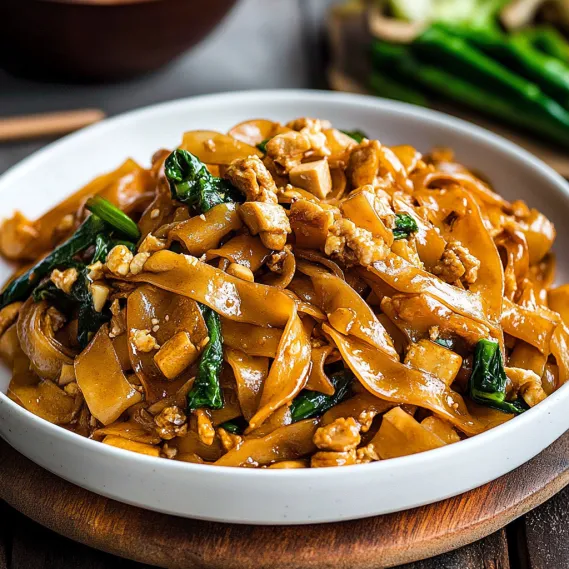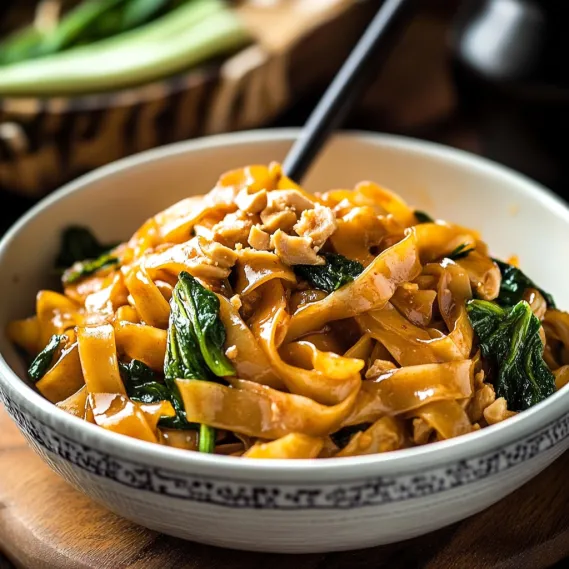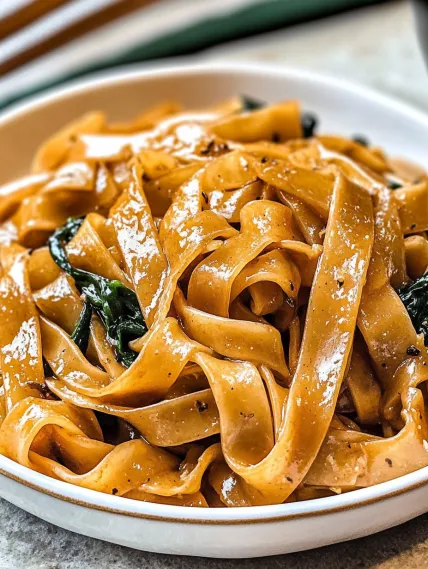 Pin it
Pin it
This authentic Pad See Ew recipe brings the beloved Thai street food directly to your home kitchen. The secret lies in cooking components separately to achieve that essential caramelization on the noodles, mimicking the intense heat of street vendor woks. You'll love how these wide rice noodles coated in a savory-sweet sauce become an addictive weeknight dinner option.
I discovered this recipe during my search for authentic Thai dishes that don't require specialized equipment. After testing countless versions I finally perfected this method that gives you those signature caramelized noodles even without a professional wok burner.
Ingredients
- Wide rice stick noodles: Provide the perfect chewy texture and absorb the flavorful sauce beautifully
- Dark soy sauce: Delivers both rich color and depth of flavor essential for authentic results
- Oyster sauce: Adds that unmistakable umami complexity that defines Thai stir fries
- Light soy sauce: Brings saltiness without overpowering the other flavors
- White vinegar: Balances the sweetness with just the right tang
- Sugar: Helps create caramelization on the noodles and balances the savory elements
- Peanut or vegetable oil: Withstands high heat cooking without smoking
- Garlic cloves: Form the aromatic foundation of authentic Thai cooking
- Chicken thighs: Stay tender during the high heat cooking process
- Egg: Adds richness and protein while creating texture contrast
- Chinese broccoli: Brings vegetable freshness and authentic flavor
How To Make Pad See Ew
- Prepare the components:
- Begin by trimming Chinese broccoli ends and separating leaves from stems. Cut stems in half lengthwise so they cook evenly. Cook noodles according to package directions timing it perfectly so they finish just before you need them. Mix all sauce ingredients in a small bowl until sugar completely dissolves.
- Cook protein and vegetables:
- Heat oil in your largest wok or skillet over high heat until shimmering. Add finely chopped garlic and stir for just 15 seconds until fragrant but not browned. Add sliced chicken and stir constantly until most pieces turn from pink to white. Add the firmer Chinese broccoli stems first allowing them a head start in cooking before introducing the more delicate leaves.
- Create egg component:
- Push all ingredients to one side of the wok creating an empty space. Crack your egg directly into this space and scramble quickly until just set but still slightly moist. This technique ensures the egg maintains its distinct texture rather than coating everything.
- Master the caramelization technique:
- Remove everything from the wok onto a waiting plate and scrape the wok completely clean. Return it to high heat with fresh oil and heat until just smoking. This extremely hot surface is crucial for proper caramelization. Add noodles and sauce then toss minimally just enough to coat everything while allowing edges to develop that signature caramelized flavor about 90 seconds.
- Combine and finish:
- Quickly return the chicken vegetable and egg mixture to the wok tossing everything together efficiently. The goal is to integrate all components while maintaining the caramelization you worked to develop. Serve immediately while piping hot for the best texture and flavor experience.
 Pin it
Pin it
Chinese broccoli is my favorite element in this dish. Its slightly bitter notes perfectly balance the sweet and savory sauce. I remember visiting Thailand and watching street vendors making this dish with such impressive speed and confidence. Their technique of keeping ingredients separate until the final moments inspired my approach to this recipe.
Noodle Selection Guide
Finding the perfect noodles makes a significant difference in your Pad See Ew. Traditional Thai restaurants use fresh wide rice noodles called Sen Yai which have an unmatched tender texture. However these can be difficult to find outside Asian markets. Dried wide rice stick noodles make an excellent substitute and are widely available in grocery stores. If using dried noodles cook them just until al dente as they will continue cooking when added to the wok. Fresh rice noodles only need a quick rinse in warm water to separate them before using.
Protein Variations
While chicken thighs provide excellent flavor and tenderness this recipe adapts beautifully to other proteins. Thinly sliced beef particularly flank steak or sirloin creates a rich version that many Thai restaurants offer. For seafood lovers shrimp cooks quickly and pairs wonderfully with the sauce profile. Vegetarians can substitute firm tofu cut into thin rectangles and lightly fried before adding to ensure proper texture. The cooking technique remains the same regardless of protein choice just adjust cooking times accordingly.
 Pin it
Pin it
Sauce Balance Secrets
The sauce combines five essential elements creating that perfect balance Thai cuisine is famous for. Dark soy provides color and depth while light soy delivers saltiness. Oyster sauce contributes complex umami notes that define the dish. White vinegar adds brightness cutting through the richness. Sugar not only balances flavors but helps achieve caramelization. If you prefer a slightly sweeter version increase sugar to 3 teaspoons. For more savory depth add an additional 1/2 tablespoon of oyster sauce. The beauty of this sauce lies in its adaptability experiment slightly to match your preference while maintaining the essential balance.
Serving Suggestions
Pad See Ew traditionally stands alone as a complete meal but can be enhanced with complementary sides. Serve with a small bowl of Thai chili vinegar on the side allowing diners to add heat according to preference. A fresh cucumber salad dressed simply with rice vinegar provides cooling contrast to the rich noodles. For a more substantial meal consider starting with Tom Yum soup or offering Thai fish cakes as an appetizer. Authentically this dish would be enjoyed with chopsticks and a spoon allowing you to capture every delicious morsel.
Frequently Asked Questions
- → What type of noodles work best for Pad See Ew?
Wide rice noodles, either fresh (Sen Yai) or dried, are ideal for Pad See Ew. If unavailable, dried rice stick noodles work well as a substitute.
- → Can I use different types of protein?
Absolutely! Chicken is traditional, but pork, beef, shrimp, or tofu are great alternatives for Pad See Ew.
- → Why should I cook the chicken separately?
Cooking the chicken separately ensures proper caramelization and prevents the noodles from stewing, resulting in authentic flavor and texture.
- → What vegetables can I use instead of Chinese broccoli?
If Chinese broccoli is unavailable, try using broccolini, regular broccoli, or bok choy as substitutes in your stir-fry.
- → How can I make this vegetarian or vegan?
To make Pad See Ew vegetarian or vegan, substitute chicken with tofu or mushrooms and use plant-based oyster sauce and soy sauce alternatives.
- → What’s the secret to caramelized noodles?
Use high heat, enough oil, and avoid over-stirring the noodles. Press them slightly against the pan for delicious caramelized edges.
